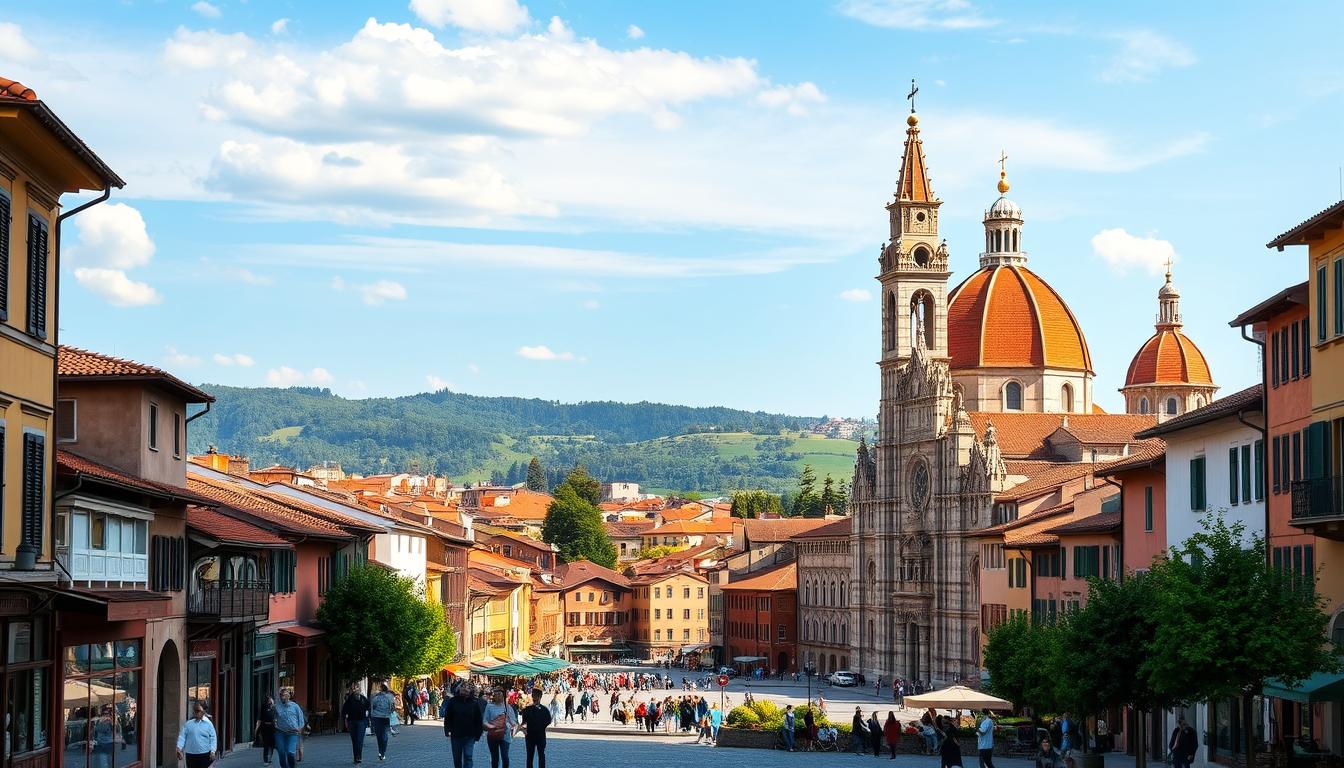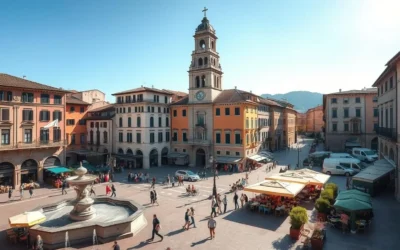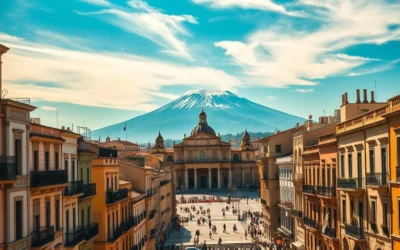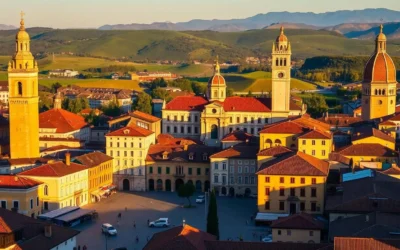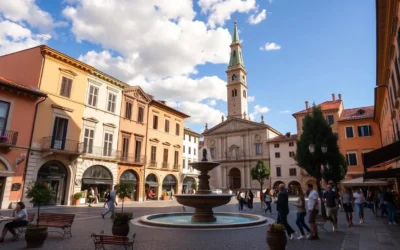✓ Tours & Activities ✓ Tours & Activities
Did you know that Padua is home to one of the oldest working clocks in the world? This charming city, also known as Padova, is a treasure trove of history, art, and culture. From stunning frescoes in the Scrovegni Chapel to the vibrant Prato della Valle, there’s something for everyone.
Whether you’re planning a day trip or a longer stay, this guide will help you discover the best thing to experience in Padua. You’ll find iconic landmarks, hidden gems, and insider tips to make your visit unforgettable. Get ready to explore a city that blends ancient traditions with modern charm.
So, why wait? Start planning your adventure and uncover the magic of this Italian destination. Padua is waiting to amaze you!
Overview of Padua’s Rich History and Vibrant Culture
With roots tracing back to Roman times, this city is a living museum of history. Founded over 3,000 years ago, it has witnessed the rise and fall of empires, making it one of Italy’s most storied destinations. From its Roman origins to its Renaissance glory, the city has preserved its heritage through stunning architecture and art.
Today, the city thrives as a hub of culture and education. Home to one of Europe’s oldest universities, it attracts students and scholars from around the world. This youthful energy blends seamlessly with its ancient traditions, creating a dynamic atmosphere that’s perfect for a one day exploration.
You’ll find a unique mix of historical landmarks and modern amenities. The city’s UNESCO World Heritage sites, like the Scrovegni Chapel and the Orto Botanico, stand alongside bustling markets and vibrant cafes. This blend of old and new makes it a destination unlike any other.
Uncover the Masterful Frescoes at the Scrovegni Chapel
Step into a world of artistic brilliance at the Scrovegni Chapel. This 14th-century gem is a UNESCO World Heritage site and a cornerstone of Western art. Its walls and ceiling are adorned with Giotto’s frescoes, which revolutionized the art world and marked the dawn of the Proto-Renaissance.
Historical Significance and Fresco Details
The chapel was commissioned by Enrico Scrovegni in the early 1300s as part of his family’s palace. Giotto’s frescoes, completed in 1305, depict biblical stories with unprecedented emotional depth and realism. The cycle includes 28 scenes, such as the Meeting at the Golden Gate and the Betrayal of Christ, each telling a story with vivid detail.
Giotto’s work broke away from medieval stylization, introducing techniques that would influence Renaissance artists. His use of perspective, color, and human emotion brought the stories to life, making the Scrovegni Chapel a masterpiece of its time.
Visitor Tips and Booking Information
Visiting this iconic chapel requires planning. Due to its popularity and conservation needs, only 25 visitors are allowed per session, and each visit lasts 15 minutes. Evening openings during summer offer extended viewing times.
Here’s a quick guide to help you plan your visit:
| Details | Information |
|---|---|
| Opening Hours | 9:00 AM – 7:00 PM (varies by season) |
| Booking | Reserve online in advance |
| Visit Duration | 15 minutes (30 minutes in summer evenings) |
| Ticket Price | €14 (includes entry to nearby museums) |
Don’t miss the chance to witness this 14th-century marvel. Book your tickets early to secure your spot and immerse yourself in the artistic legacy of the Scrovegni Chapel.
Experience the Spiritual Majesty of the Basilica of Saint Anthony
The Basilica of Saint Anthony stands as a testament to centuries of faith and artistry. This iconic building is a blend of Romanesque, Gothic, and Byzantine styles, making it a masterpiece of architectural diversity. Its spiritual significance attracts millions of visitors each year, offering a profound experience for pilgrims and tourists alike.
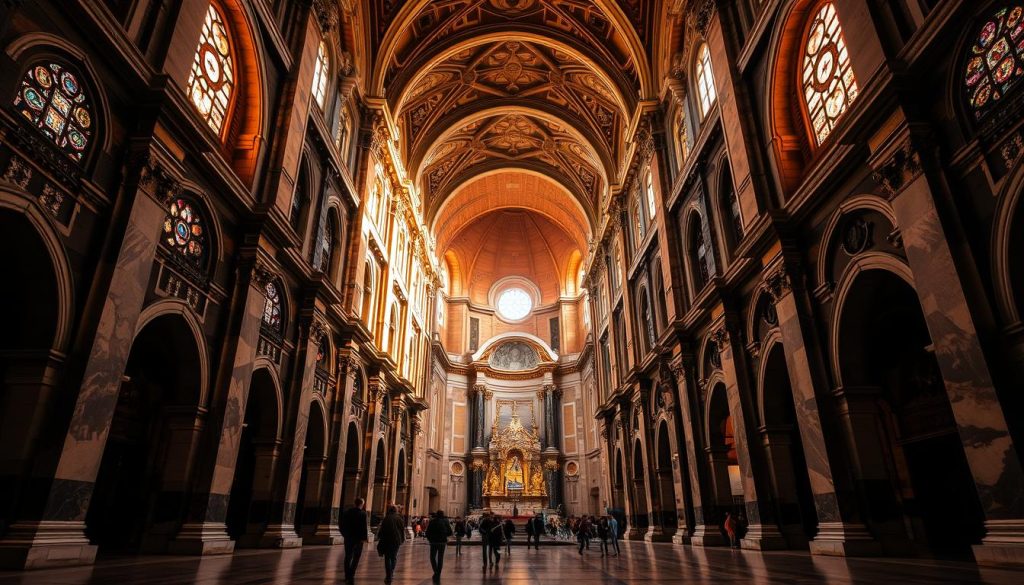
Architectural Highlights and Cultural Traditions
The basilica’s vaulted ceilings and intricate details are a feast for the eyes. Inside, you’ll find stunning artworks, including bronze sculptures by Donatello, a Renaissance master. These pieces add to the centuries-old legacy of the site, blending art and devotion seamlessly.
As one of the most visited pilgrimage sites, the basilica holds a special place in the hearts of many. Its cultural traditions, such as the veneration of Saint Anthony, create a deeply spiritual atmosphere. Whether you’re drawn by faith or art, this building offers something truly unique.
Practical Visiting Tips
To make the most of your visit, plan ahead. Early mornings or late afternoons are the best times to avoid crowds. Local tour options are available for a more immersive experience, providing insights into the basilica’s history and significance.
Despite its popularity, the basilica remains free to enter, making it accessible to all. Here’s a quick guide to help you plan your visit:
| Details | Information |
|---|---|
| Opening Hours | 6:30 AM – 7:00 PM (varies by season) |
| Best Time to Visit | Early morning or late afternoon |
| Entry Fee | Free |
| Tour Options | Guided tours available locally |
Visiting the Basilica of Saint Anthony is more than just a tour; it’s a journey through centuries of art, faith, and history. Take your time to soak in the spiritual majesty of this remarkable site.
Revitalize Your Senses at Prato della Valle
Discover the open-air charm of Prato della Valle, a place where history meets relaxation. This expansive square is one of the largest in Europe, offering a perfect blend of beauty and culture. Whether you’re looking for a leisurely stroll or a moment of serenity, this iconic spot has it all.
The square is defined by its oval shape, surrounded by 78 statues and a central canal. These statues depict historical figures, adding a touch of grandeur to the space. The canal, with its tranquil waters, enhances the aesthetic appeal, making it a favorite spot for photos and relaxation.
Historically, Prato della Valle has been a hub for public events. From theatrical performances in the past to modern festivals and markets, it has always been a lively gathering place. Today, it continues to host vibrant events, drawing locals and tourists alike.
Here’s a quick guide to help you explore this historic square:
| Feature | Details |
|---|---|
| Statues | 78 historical figures |
| Central Canal | Picturesque water feature |
| Events | Festivals, markets, and performances |
| Best Time to Visit | Early morning or late afternoon |
Take your time to soak in the atmosphere of Prato della Valle. Whether you’re admiring the statues, enjoying the canal, or simply people-watching, this square offers a unique experience. Let its charm revitalize your senses and leave you with lasting memories.
Step Back in Time at the University of Padua
Journey through centuries of academic excellence at the University of Padua. Founded in 1222, this institution is one of the oldest in the world. It has shaped the minds of countless scholars and remains a beacon of knowledge and innovation.
The university padua has a storied past. It was established during a time when academic freedom was rare. This spirit of independence continues to define its identity. Its historic buildings, with their timeless architecture, offer a glimpse into its rich heritage.
Many famous figures have walked its halls. Galileo Galilei, a pioneer of modern science, taught here. His groundbreaking work on astronomy and physics began within these walls. The University of Padua also celebrated a historic milestone in 1678. Elena Lucrezia Cornaro Piscopia became the first woman to earn a doctorate degree from this esteemed institution.
Visitors can explore the campus through guided tours. These tours highlight the university’s historic significance and its role in shaping modern education. You’ll see centuries-old lecture halls, libraries, and courtyards that still buzz with intellectual energy.
Today, the university padua blends its historic roots with modern advancements. It remains a vibrant center for research and learning. A visit here is not just a trip through time but also an opportunity to witness the future of education in action.
Plan your visit to this iconic institution. Whether you’re a history enthusiast or a curious traveler, the University of Padua offers an unforgettable experience. Step into its storied halls and discover the legacy of one of the world’s most prestigious universities.
Savor Local Flavors at the Traditional Padua Market
Immerse yourself in the vibrant heart of Padua’s daily life at its historic market. For over 800 years, this bustling hub has been a cornerstone of the city’s culture, offering everything from fresh produce to handmade crafts. It’s a thing padua locals and visitors alike cherish.

The atmosphere is electric, with vendors calling out their wares and the air filled with the aroma of spices and baked goods. You’ll find a wide variety of items, from seasonal fruits and vegetables to artisanal cheeses and cured meats. This is the perfect place to pick up unique souvenirs or simply enjoy the local vibe.
Beyond shopping, the market is a cultural meeting point. It’s where traditions are preserved and shared, making it a must-visit on your trip. Whether you’re sampling regional delicacies or chatting with friendly vendors, you’ll feel the authentic pulse of the city.
Here’s a quick guide to help you navigate this historic venue:
| Details | Information |
|---|---|
| Opening Hours | 6:00 AM – 2:00 PM (varies by stall) |
| Best Time to Visit | Early morning for fresh produce |
| Highlights | Local spices, handmade goods, and artisanal foods |
| Tips | Bring cash and check stall-specific hours |
Visiting the market is more than just a shopping experience—it’s a journey into the heart of Padua’s culture. Take your time to explore, taste, and connect with the vibrant spirit of this historic venue.
Embrace Nature in the Historic Botanical Garden
Step into a living museum of nature at the historic Botanical Garden. Founded in 1545, this UNESCO World Heritage site is the world’s oldest academic garden. It’s a place where science, history, and natural beauty come together, offering a serene escape in the heart of the city.
Garden Evolution and Design
The garden was originally designed in a circular layout, reflecting Renaissance ideals of harmony and balance. Over the centuries, it expanded to include diverse plant collections and modern additions like the Biodiversity Garden, housed in a sleek glass structure. This blend of old and new showcases its evolution from a medicinal herb garden to a hub of global botanical research.
Top Plant Species and Must-See Areas
Among its many treasures, the botanical garden is home to the centuries-old Mediterranean dwarf palm, a living testament to its enduring legacy. Other highlights include rare orchids, carnivorous plants, and a collection of medicinal herbs that trace back to its origins. Each section of the garden tells a story, making it a must-visit for nature lovers and history enthusiasts alike.
Here’s a quick guide to help you plan your visit:
| Details | Information |
|---|---|
| Opening Hours | 9:00 AM – 7:00 PM (varies by season) |
| Ticket Price | €10 (discounts for students and groups) |
| Highlights | Mediterranean dwarf palm, Biodiversity Garden |
| Tips | Check updated opening hours before visiting |
As a UNESCO World Heritage site, the Botanical Garden is more than just a garden—it’s a journey through centuries of scientific discovery and natural wonder. Take your time to explore its lush landscapes and uncover the stories behind its remarkable plant collections.
Admire the Ingenious Padua Astronomical Clock
Marvel at the intricate craftsmanship of one of the world’s oldest working clocks. The Padua Astronomical Clock is a testament to medieval engineering, blending art and science in a way that continues to captivate visitors. Its 24-hour dial not only tells time but also tracks the phases of the moon and planetary movements, making it a marvel of its era.
The clock’s design is a masterpiece of precision. Every minute detail, from the intricate gears to the celestial symbols, reflects the ingenuity of its creators. The 24-hour dial is particularly fascinating, offering a unique way to track time that differs from modern clocks. It’s a reminder of how timekeeping has evolved over the centuries.
Historically, this clock holds immense significance. Built in the 14th century, it’s one of the few surviving examples of medieval astronomical timepieces. Its ability to display lunar phases and planetary positions was groundbreaking at the time, showcasing the advanced knowledge of its creators.
If you’re planning to visit, here’s what you need to know:
| Details | Information |
|---|---|
| Location | Clock Tower, Piazza dei Signori |
| Best Time to Visit | Early morning or late afternoon |
| Guided Tours | Available for clock tower exploration |
| Fun Fact | Missing zodiac elements add to its mystery |
Take your time to appreciate the clock’s detailed craftsmanship. Whether you’re a history buff or simply curious, this medieval wonder offers a unique way to connect with the past. Don’t rush—every minute spent here is a step back in time.
Discover the Architectural Wonders of Padua Cathedral
Uncover the layers of history and artistry at the Padua Cathedral. Known as the Cathedral of the Assumption of the Virgin Mary, this iconic site dates back to the 4th century. Its long history is a testament to its enduring significance in the city’s religious and cultural landscape.
The cathedral’s exterior is strikingly simple, with an austere facade that belies the treasures within. Step inside, and you’ll be greeted by a richly decorated interior filled with stunning frescoes and intricate details. The contrast between the modest exterior and the ornate interior is a hallmark of its design.
Adjacent to the cathedral, you’ll find the Baptistery and the Diocesan Museum. These attractions offer deeper insights into the cathedral’s history and artistry. The museum houses a remarkable collection of religious artifacts and artworks, making it a must-visit for history enthusiasts.
To fully explore the cathedral and its hidden areas, purchasing a ticket is essential. This grants access to the museum and other restricted sections, allowing you to appreciate every detail. Plan your visit early to avoid crowds and make the most of your experience.
The Padua Cathedral is more than just a religious site—it’s a central piece of the city’s heritage. Its frescoes, architecture, and historical artifacts tell a story of faith and creativity that spans centuries. Take your time to explore and immerse yourself in its timeless beauty.
Here’s a quick guide to help you plan your visit:
| Details | Information |
|---|---|
| Opening Hours | 9:00 AM – 6:00 PM (varies by season) |
| Ticket Price | €10 (includes museum access) |
| Highlights | Frescoes, Baptistery, Diocesan Museum |
| Tips | Buy tickets online to save time |
Whether you’re drawn by faith, art, or history, the Padua Cathedral offers a journey through time. Don’t miss the chance to discover its architectural wonders and the stories they hold.
Stroll Through Iconic Streets of Padua’s Historic Center
Take a leisurely walk through the heart of Padua’s historic center and uncover its timeless charm. The streets here are a blend of history and modern vibrancy, offering a perfect setting for a relaxed exploration. From bustling squares to quiet alleys, every corner tells a story.
Start your journey at Piazza dei Signori, a lively square that has been a gathering place for centuries. Its historic clock tower and vibrant cafes make it a great spot to soak in the local atmosphere. Nearby, Piazza delle Erbe offers a glimpse into daily life with its bustling market and colorful stalls.
Hidden Neighborhood Gems
As you wander further, you’ll discover hidden gems like the ancient Jewish ghetto and quiet courtyards tucked away from the main tourist paths. These areas are perfect for those who want to experience the authentic side of the city. Artisanal shops and local boutiques line the streets, offering unique finds and a chance to connect with local culture.
Popular pedestrian streets like Via Umberto I and Via Roma are ideal for people-watching and leisurely strolls. These pathways are lined with charming architecture, inviting cafes, and small shops that reflect the city’s rich history and modern energy.
For the best experience, plan your walk in the early morning or late afternoon. These times offer cooler weather and fewer crowds, allowing you to fully enjoy the serenity of the historic center. Exploring on foot also gives you the freedom to discover unexpected treasures and hidden corners.
Don’t limit yourself to the main tourist spots. Venture into the quieter neighborhoods to find authentic local experiences. Whether it’s a hidden courtyard or a small artisan shop, these discoveries will make your visit truly memorable.
Here’s a quick guide to help you plan your stroll:
| Details | Information |
|---|---|
| Best Time to Visit | Early morning or late afternoon |
| Highlights | Piazza dei Signori, Piazza delle Erbe, Via Umberto I |
| Tips | Wear comfortable shoes and bring a map |
Take your time to explore the streets of Padua’s historic center. Every step reveals a new layer of history, culture, and charm. Let the city’s timeless beauty inspire your journey.
Indulge in a Coffee Break at Caffè Pedrocchi
Step into a timeless haven of culture and caffeine at Caffè Pedrocchi. This iconic café, the oldest in the city, has been a gathering place for intellectuals, artists, and locals since 1831. Its elegant interiors and storied history make it a must-visit spot for anyone exploring the area.
Iconic Beverages and Menu Highlights
One of the café’s standout offerings is its famous mint coffee. Served without stirring, this unique drink combines rich espresso with a refreshing mint flavor. Every person who tries it leaves with a memorable experience. The menu also features a variety of pastries, sandwiches, and other beverages, perfect for a light snack or a full meal.
Cultural Legacy and Historic Ambiance
Caffè Pedrocchi is more than just a café—it’s a cultural institution. Its grand halls and intricate decor reflect the city’s rich heritage. Over the years, it has hosted poets, politicians, and thinkers, making it a cornerstone of social history. The ambiance transports you to a bygone era, offering a glimpse into the past.
To make the most of your visit, check the opening hour and consider reserving a table during peak times. Whether you’re stopping by for a quick coffee or a leisurely break, this café promises an unforgettable experience. Take your time to savor the flavors and soak in the historic charm of Caffè Pedrocchi.
Enjoy Scenic Cruises Along the Brenta Canal
Embark on a journey through time and luxury as you cruise along the Brenta Canal. This man-made waterway, stretching from Venice to Padua, offers a unique way to experience the region’s historical elegance and natural beauty. Whether you’re looking to spend a memorable day on the water or admire stunning riverside views, this cruise is a must-do.

Luxury Villas and Riverside Views
As you glide along the canal, you’ll pass by opulent villas originally built for Venetian aristocrats. These architectural marvels, such as Villa Pisani and Villa Foscari, showcase intricate details and lush gardens. Each villa tells a story of the region’s rich history and cultural heritage.
The serene riverside landscapes add to the charm of the cruise. You’ll see picturesque scenes of nature, from tranquil waters to vibrant greenery. It’s a perfect blend of relaxation and cultural discovery, making it a highlight of any trip.
Booking and Tour Tips
To make the most of your experience, consider booking a guided cruise. These tours often include visits to several villas, providing deeper insights into their history and significance. Here’s a quick guide to help you plan your day:
| Details | Information |
|---|---|
| Tour Duration | Approximately 9 hours |
| Highlights | Villa Pisani, Villa Foscari, Villa Widmann |
| Booking | Reserve online in advance |
| Best Time to Visit | Spring or early autumn |
Take your time to explore this enchanting place. Whether you’re a history enthusiast or simply looking for a relaxing escape, the Brenta Canal cruise offers an unforgettable experience. Let the beauty of the canal and its villas capture your heart.
Explore Art and History at Palazzo Zuckermann
Dive into a world of artistic treasures at Palazzo Zuckermann. This cultural gem is a must-visit for anyone interested in art and history. The palace houses two distinct museums, each offering a unique glimpse into the city’s rich heritage. From Medieval artifacts to Renaissance masterpieces, every exhibit tells a story.
The first museum focuses on applied and decorative arts. Here, you’ll find intricate ceramics, textiles, and furniture that showcase the craftsmanship of past centuries. The second museum highlights historical paintings and sculptures, featuring works by renowned artists. Together, these collections provide a comprehensive view of the region’s artistic evolution.
One of the highlights is the Medieval section, where you can admire rare artifacts from the 12th to 15th centuries. The Renaissance exhibits are equally impressive, with detailed sculptures and vibrant paintings. Each piece reflects the creativity and skill of its time, making this museum a true treasure trove.
To make the most of your visit, plan ahead. Here’s a quick guide to help you:
| Details | Information |
|---|---|
| Opening Hours | 10:00 AM – 6:00 PM (Closed Mondays) |
| Ticket Price | €8 (Discounts for students and seniors) |
| Highlights | Medieval artifacts, Renaissance art, decorative arts |
| Tips | Check for guided tours to enhance your experience |
Palazzo Zuckermann is more than just a museum—it’s a window into the city’s artistic soul. Take your time to explore each exhibit and appreciate the detailed craftsmanship. Whether you’re an art enthusiast or a history buff, this thing will leave you inspired.
Taste Authentic Italian Cuisine and Local Specialties
Savor the flavors of a city steeped in culinary tradition. From hearty pasta dishes to delicate pastries, the local cuisine offers a feast for the senses. Each dish tells a story of centuries-old recipes and regional pride.
Start with Bigoli, a thick, spaghetti-like pasta often served with duck ragu. This dish is a staple in the piazza delle area, where traditional recipes are celebrated. Another must-try is Risotto coi rovinassi, a rich risotto made with chicken giblets, showcasing the region’s resourcefulness.
For a lighter option, try Spunciotti, small skewers of meat or vegetables that are perfect for sharing. These are often enjoyed in the bustling prato della market, where locals gather for fresh, seasonal ingredients.
Here’s a quick guide to the best dining spots:
| Dish | Where to Try |
|---|---|
| Bigoli | Ristorante da Giovanni |
| Risotto coi rovinassi | La Folperia |
| Spunciotti | Pasticceria Graziati |
Pair your meal with a glass of local Prosecco or Valpolicella wine. These wines, produced in the nearby Veneto region, complement the flavors perfectly. Don’t forget to end your meal with a traditional tramezzino, a triangular sandwich filled with fresh ingredients.
Exploring the piazza delle and prato della areas offers more than just a meal—it’s a journey into the heart of Italian gastronomy. Take your time to savor each bite and appreciate the craftsmanship behind every dish.
Here are some practical tips for your culinary adventure:
- Visit local markets for fresh, seasonal ingredients.
- Ask for recommendations from restaurant staff.
- Try regional wines to enhance your dining experience.
Whether you’re a food enthusiast or a curious traveler, this city’s cuisine will leave a lasting impression. Let the flavors of piazza delle and prato della guide your journey through its rich culinary heritage.
Padua, Italy: Best Things to Do – Top Picks
From ancient marvels to vibrant markets, this destination offers a journey through time. Each attraction represents a unique facet of its storied past and vibrant present. Whether you’re planning a day trip or a longer stay, this guide will help you navigate the highlights with ease.
Start your adventure at the Scrovegni Chapel, a UNESCO World Heritage site. Its breathtaking frescoes by Giotto are a must-see. Plan your visit during the early hour to avoid crowds and fully appreciate the artistry. Nearby, the Basilica of Saint Anthony offers a spiritual retreat, with its stunning architecture and rich history. Entry is free, making it accessible to all.
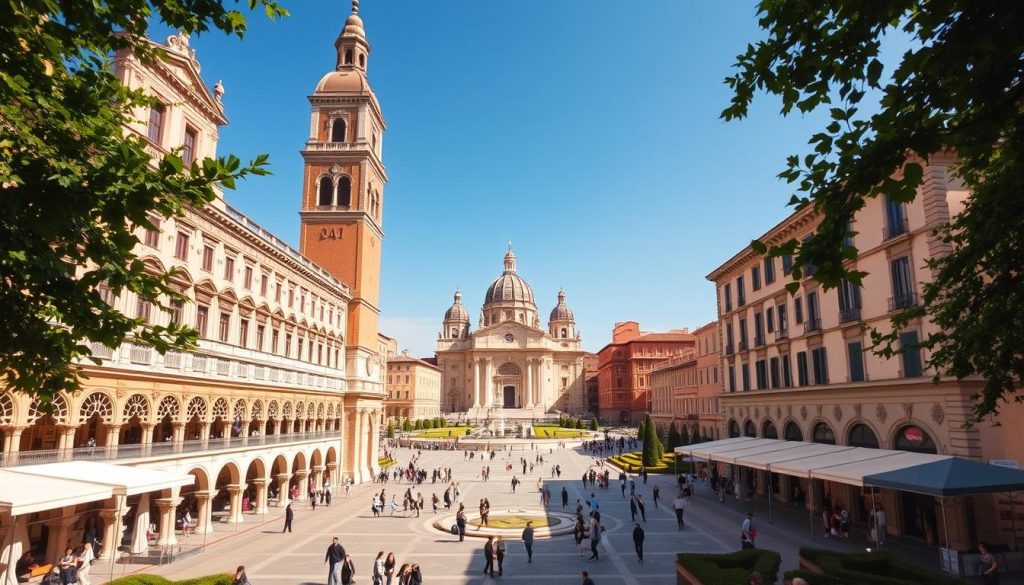
For a dose of nature, head to the Botanical Garden, the world’s oldest academic garden. Its lush landscapes and diverse plant collections are perfect for a leisurely stroll. Visit in the late afternoon hour for a serene experience. Don’t miss the centuries-old Mediterranean dwarf palm, a living testament to its enduring legacy.
Explore the vibrant Prato della Valle, one of Europe’s largest squares. Its 78 statues and central canal create a picturesque setting. Early mornings are the best hour to enjoy its tranquility. For a taste of local life, visit the bustling market at Piazza delle Erbe, where fresh produce and artisanal goods abound.
Step into the historic Piazza dei Signori, home to the iconic astronomical clock. Its 24-hour dial and intricate design are a marvel of medieval engineering. Guided tours are available for a deeper dive into its history. Nearby, Palazzo Zuckermann houses two museums showcasing decorative arts and historical paintings, offering a glimpse into the city’s artistic evolution.
Here’s a quick guide to help you plan your day:
| Attraction | Best Hour to Visit |
|---|---|
| Scrovegni Chapel | Early morning |
| Basilica of Saint Anthony | Late afternoon |
| Botanical Garden | Late afternoon |
| Prato della Valle | Early morning |
| Piazza delle Erbe | Mid-morning |
| Piazza dei Signori | Early evening |
Use this summary as your checklist for an unforgettable experience. Each site offers a unique perspective on the city’s rich heritage. Take your time to explore, and let the magic of this destination captivate you.
Conclusion
Your journey through this historic city is a blend of timeless charm and modern allure. Every part of your adventure offers something unique, from ancient landmarks to vibrant cultural hubs. Whether you arrive by train or another mode of transport, the city’s accessibility ensures a seamless experience.
Take your time to explore and savor each moment. The blend of history and contemporary vibrancy creates an enriching atmosphere that’s hard to forget. Practical tips, like booking tickets in advance and visiting during quieter hours, can enhance your trip.
Thank you for exploring this guide. We hope it inspires you to uncover the magic of this destination. Share your experiences and revisit this resource for future trips. Safe travels and enjoy every step of your journey!
The above is subject to change.
Check back often to TRAVEL.COM for the latest travel tips and deals.
